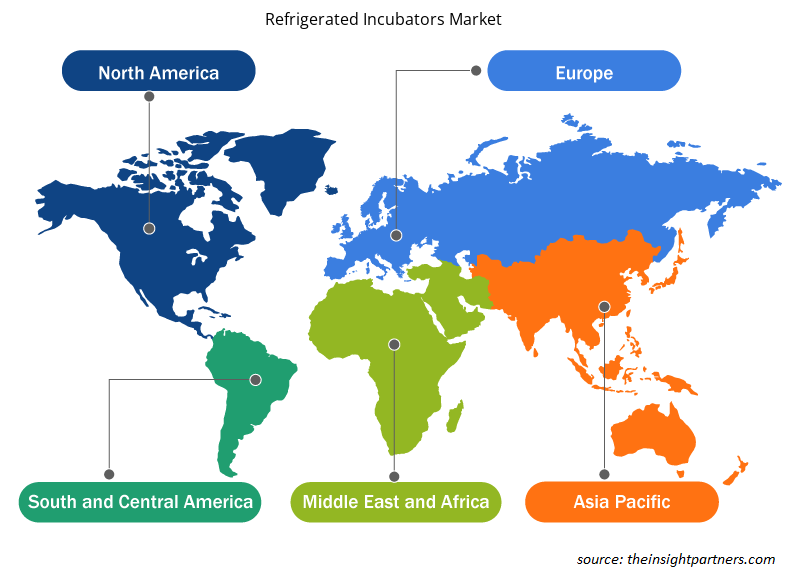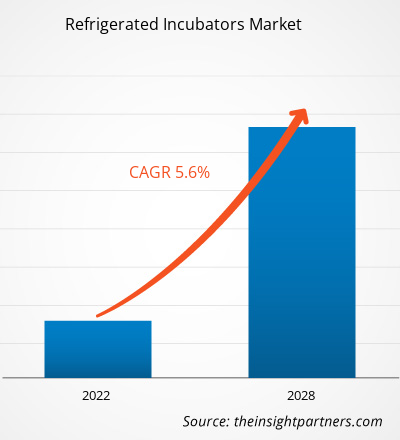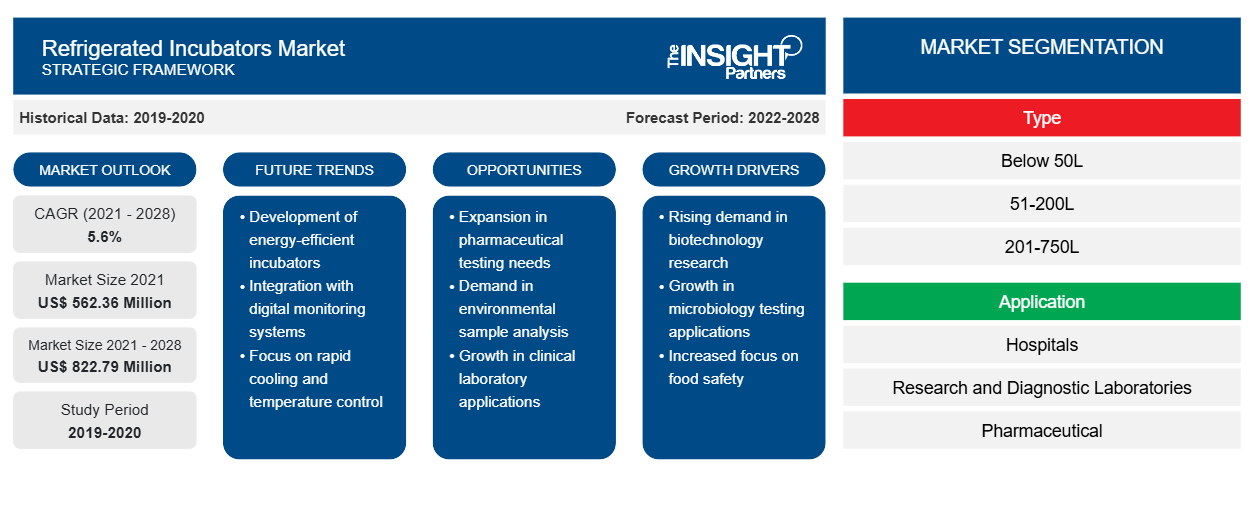Se proyecta que el mercado de incubadoras refrigeradas alcance los US$ 822,79 millones para 2028 desde los US$ 562,36 millones en 2021; se espera que crezca a una CAGR del 5,6% entre 2021 y 2028.
La alta adopción de incubadoras refrigeradas por parte de los centros de investigación o laboratorios impulsa el crecimiento del mercado. En el sector médico, trabajar con microorganismos juega un papel fundamental. La producción y multiplicación eficiente de microorganismos requiere una fase de incubación estable. Con la llegada de la tecnología, los investigadores han optado por la utilidad de incubadoras o equipos basados en tecnología avanzada que apuntan a un consumo de energía eficiente en comparación con las incubadoras de refrigeración tradicionales. Por ejemplo, el uso de incubadoras de refrigeración en centros de investigación, centros farmacéuticos y biotecnológicos y laboratorios es alto, ya que reduce el consumo de energía y minimiza la distribución desigual de la temperatura. Además, varios de los principales actores competitivos, como Binder GmBH, diseñan incubadoras refrigeradas con características únicas, como una unidad de compresión-refrigeración, que garantiza un flujo de temperatura constante. Además, las incubadoras refrigeradas funcionan con una tecnología convencional particular que proporciona una temperatura estable y continua dentro de la cámara de la incubadora.
Además, con los grandes avances y el crecimiento en el campo de la biología a través de la afluencia de productos farmacéuticos, zoología, microbiología, genética y ecología, la demanda de incubadoras refrigeradas basadas en tecnología avanzada es máxima. Los principales actores competitivos, como Being Scientific Inc., ofrecen incubadoras refrigeradas basadas en tecnología avanzada para facilitar el crecimiento y almacenamiento de muestras biológicas. Además, las ofertas de productos de la empresa tienen un gran cambio o enfoque hacia el diseño de incubadoras refrigeradas basadas en tecnología avanzada que comprenden aplicaciones críticas. Estas incluyen la demanda biológica de oxígeno (DBO), eficaz para pruebas de aguas residuales con una gran aplicabilidad en laboratorios de microbiología, laboratorios de biología celular y laboratorios farmacéuticos que demuestran ser eficaces para el almacenamiento de medicamentos y muestras biológicas. Por lo tanto, el aumento de las actividades de I+D y los principales actores que contribuyen a los lanzamientos de productos innovadores relacionados con las incubadoras refrigeradas dan como resultado una alta aceptación en todo el mundo. Dichas actividades impulsan aún más las ventas en todo el mercado mundial de incubadoras refrigeradas .
Personalice este informe según sus necesidades
Obtendrá personalización en cualquier informe, sin cargo, incluidas partes de este informe o análisis a nivel de país, paquete de datos de Excel, así como también grandes ofertas y descuentos para empresas emergentes y universidades.
-
Obtenga las principales tendencias clave del mercado de este informe.Esta muestra GRATUITA incluirá análisis de datos, desde tendencias del mercado hasta estimaciones y pronósticos.
La creciente adopción de incubadoras refrigeradas y el aumento de la financiación gubernamental destinada a actividades de I+D ofrecerían oportunidades lucrativas para el mercado mundial de incubadoras refrigeradas durante el período de pronóstico. El informe de la Biblioteca Pública de Ciencias (PLOS) afirma que en los últimos años se han observado numerosos desafíos relacionados con la lucha contra las enfermedades infecciosas emergentes, en particular la resistencia a los antimicrobianos (RAM) y las enfermedades desatendidas (ED). Por ejemplo, el Grupo de Trabajo Consultivo de Expertos (CEWG) se centra en la financiación de la I+D, y la coordinación en la Organización Mundial de la Salud (OMS) sugirió buscar alternativas relacionadas con la financiación e incentivos de la I+D tanto para la innovación como para el acceso a las enfermedades infecciosas emergentes. Para que conste, el CEWG y la Comisión Lancet anunciaron una financiación mundial de la atención sanitaria de 6.000 millones de dólares anuales para la resistencia a los antimicrobianos (RAM) y 10.000 millones de dólares para las infecciones emergentes. Por lo tanto, con el aumento de las actividades de I+D dirigidas a las enfermedades infecciosas emergentes y la RAM, la adopción de incubadoras refrigeradas ha aumentado drásticamente a lo largo de los años.
En la actualidad, los fabricantes están canalizando fondos para actividades de investigación y desarrollo con el fin de introducir productos basados en incubadoras refrigeradas rentables y sofisticadas en todo el mundo. Los principales actores competitivos, como Thermo Fischer Scientific, anunciaron el lanzamiento de nuevas incubadoras refrigeradas en mercados regionales, como Europa, Asia Pacífico y América Latina. Los sistemas son capaces de una amplia aplicación en las industrias farmacéutica, de ciencias biológicas, tratamiento de agua, microbiológica y pruebas de DBO. Los factores antes mencionados impulsarían el crecimiento del mercado mundial de incubadoras refrigeradas durante 2021-2028.
Es probable que América del Norte domine el mercado mundial de incubadoras refrigeradas durante 2021-2028. Estados Unidos tiene la mayor participación de mercado en esta región. Según el informe de Clinical Trials.gov, la New York Stem Cell Foundation (NYSCF) realiza investigaciones para estudiar diferentes afecciones y enfermedades mediante el uso de células madre y otros tipos de células, realizando investigaciones sobre especímenes/muestras biológicas, realizando pruebas genéticas y almacenando estas muestras durante un corto período de tiempo con la intención de usarlas en el futuro. Además, los investigadores de los laboratorios estadounidenses están creando células productoras de insulina pancreatina para identificar la diabetes tipo 1, las células cerebrales y la enfermedad de Parkinson. Estos factores respaldan en gran medida la adopción de incubadoras refrigeradas en los laboratorios estadounidenses. Además, solo en Estados Unidos, hay más de 40.000 laboratorios de investigación individuales ubicados en campus universitarios que participan en el avance del campo de las ciencias biológicas y biomédicas. La investigación comprende extensas muestras biológicas de estudios clínicos y de campo, lo que representa un enorme valor científico y financiero para los investigadores y las organizaciones, como empresas biotecnológicas/farmacéuticas, biobancos, institutos de investigación y universidades. Se espera que los factores antes mencionados impulsen el crecimiento del mercado mundial de incubadoras refrigeradas durante el período de pronóstico.
Información sobre aplicaciones
Según la aplicación, el mercado mundial de incubadoras refrigeradas se segmenta en hospitales, laboratorios de investigación y diagnóstico; empresas farmacéuticas, cosmecéuticas y biotecnológicas; institutos de investigación y académicos; y otros. Se estima que el segmento de hospitales, laboratorios de investigación y diagnóstico representará la mayor participación de mercado durante 2021-2028. Los hospitales desempeñan un papel importante al ofrecer una amplia gama de servicios médicos a los pacientes que padecen diversas enfermedades. Por lo tanto, la creciente adopción de incubadoras refrigeradas en los hospitales es alta debido a la creciente prevalencia de infecciones crónicas y al mejor tratamiento de trastornos complejos. Además, en los laboratorios de investigación y diagnóstico, existe una adopción significativa de este tipo de incubadoras, ya que el almacenamiento de muestras requiere diferentes tipos de incubadoras refrigeradas. Por lo tanto, los factores antes mencionados impulsarían el crecimiento del mercado mundial de incubadoras refrigeradas para este segmento durante 2021-2028.
Las empresas que operan en el mercado global de incubadoras refrigeradas adoptan la estrategia de innovación de productos para satisfacer las cambiantes demandas de los clientes en todo el mundo, lo que también les permite mantener su marca en el mercado global.
Perspectivas regionales del mercado de incubadoras refrigeradas
Los analistas de Insight Partners explicaron en detalle las tendencias y los factores regionales que influyen en el mercado de incubadoras refrigeradas durante el período de pronóstico. Esta sección también analiza los segmentos y la geografía del mercado de incubadoras refrigeradas en América del Norte, Europa, Asia Pacífico, Oriente Medio y África, y América del Sur y Central.

- Obtenga datos regionales específicos para el mercado de incubadoras refrigeradas
Alcance del informe de mercado de incubadoras refrigeradas
| Atributo del informe | Detalles |
|---|---|
| Tamaño del mercado en 2021 | US$ 562,36 millones |
| Tamaño del mercado en 2028 | US$ 822,79 millones |
| CAGR global (2021-2028) | 5,6% |
| Datos históricos | 2019-2020 |
| Período de pronóstico | 2022-2028 |
| Segmentos cubiertos |
Por tipo
|
| Regiones y países cubiertos |
América del norte
|
| Líderes del mercado y perfiles de empresas clave |
|
Densidad de actores del mercado de incubadoras refrigeradas: comprensión de su impacto en la dinámica empresarial
El mercado de incubadoras refrigeradas está creciendo rápidamente, impulsado por la creciente demanda de los usuarios finales debido a factores como la evolución de las preferencias de los consumidores, los avances tecnológicos y una mayor conciencia de los beneficios del producto. A medida que aumenta la demanda, las empresas amplían sus ofertas, innovan para satisfacer las necesidades de los consumidores y aprovechan las tendencias emergentes, lo que impulsa aún más el crecimiento del mercado.
La densidad de actores del mercado se refiere a la distribución de las empresas o firmas que operan dentro de un mercado o industria en particular. Indica cuántos competidores (actores del mercado) están presentes en un espacio de mercado determinado en relación con su tamaño o valor total de mercado.
Las principales empresas que operan en el mercado de incubadoras refrigeradas son:
- Binder GmbH
- Termo-Fischer Scientific Inc.
- Corporación holding PHC
- Eppendorf AG
- Instrumentos Amerex, Inc.
Descargo de responsabilidad : Las empresas enumeradas anteriormente no están clasificadas en ningún orden particular.

- Obtenga una descripción general de los principales actores clave del mercado de incubadoras refrigeradas
Segmentación del mercado mundial de incubadoras refrigeradas
Según el tipo, el mercado mundial de incubadoras refrigeradas se segmenta en menos de 50L, 51–200L, 201–750L, 751–1500L y más de 1501L. Por aplicación, el mercado se segmenta en hospitales, laboratorios de investigación y diagnóstico; empresas farmacéuticas, cosmecéuticas y biotecnológicas; institutos de investigación y académicos; y otros. Según la geografía, el mercado mundial de incubadoras refrigeradas se segmenta principalmente en América del Norte, Europa, Asia Pacífico, Oriente Medio y África (MEA), y América del Sur y Central. El mercado de América del Norte se segmenta además en EE. UU., Canadá y México. El mercado europeo de incubadoras refrigeradas se subsegmenta en Francia, Alemania, Reino Unido, España, Italia y el resto de Europa. El mercado de Asia Pacífico se subsegmenta en China, India, Japón, Australia, Corea del Sur y el resto de APAC. El mercado de incubadoras refrigeradas en Oriente Medio y África se segmenta a su vez en Arabia Saudita, Emiratos Árabes Unidos, Sudáfrica y el resto de Oriente Medio y África. El mercado de América del Sur y Central se subdivide en Brasil, Argentina y el resto de América del Sur y Central.
Perfiles de empresas
- Binder GmbH
- Termo-Fischer Scientific Inc.
- Corporación holding PHC
- Eppendorf AG
- Instrumentos Amerex, Inc.
- Fabricación Sheldon, Inc.
- Compañía: LEEC Ltd.
- Memmert GmbH+ Co. KG
- Referencia científica
- Compañía: Gilson Inc.
- Análisis histórico (2 años), año base, pronóstico (7 años) con CAGR
- Análisis PEST y FODA
- Tamaño del mercado, valor/volumen: global, regional y nacional
- Industria y panorama competitivo
- Conjunto de datos de Excel
Informes recientes
Testimonios
Razón para comprar
- Toma de decisiones informada
- Comprensión de la dinámica del mercado
- Análisis competitivo
- Información sobre clientes
- Pronósticos del mercado
- Mitigación de riesgos
- Planificación estratégica
- Justificación de la inversión
- Identificación de mercados emergentes
- Mejora de las estrategias de marketing
- Impulso de la eficiencia operativa
- Alineación con las tendencias regulatorias























 Obtenga una muestra gratuita para - Mercado de incubadoras refrigeradas
Obtenga una muestra gratuita para - Mercado de incubadoras refrigeradas